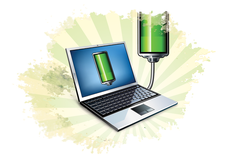Tools for checking ACPI battery data
Fully Charged

Linux offers some useful command-line tools that leverage the ACPI power management framework to display detailed data on the status of a laptop battery.
The quality of life for any laptop owner depends on the battery maintaining enough charge to operate off the power grid. Eventually, however, you will see a message informing you that the charge has reached a minimum threshold, and you have to save your data quickly or else switch to mains mode to continue working while the battery charges in the background.
The data for the warning message come from the Advanced Configuration and Power Interface (ACPI) [1] [2]. ACPI, which first appeared in 1996, has now replaced its predecessor, Advanced Power Management (APM); the current version 6 dates from April 2015. (For more information on APM and ACPI check out TuxMobil [3] and the ACPI how-to [4].)
ACPI used to be a separate component in Linux, but the Linux kernel developers now maintain ACPI functionality within the framework of the Unified Extensible Firmware Interface (UEFI) [5]. Linux comes with some command-line tools that let you read information on battery status and health. For Debian and its derivatives, you'll need the acpi, acpid, and acpi-support-base packages.
[...]
Buy this article as PDF
(incl. VAT)
